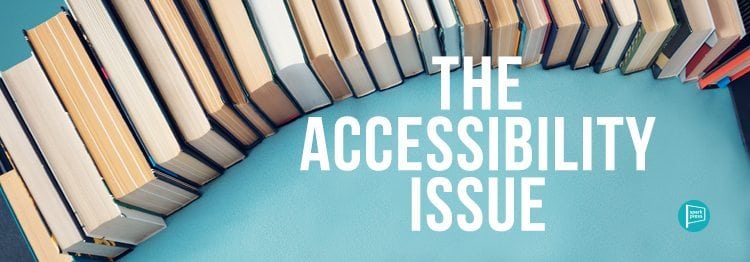
When we think about accessibility, we usually think about things like wheelchair ramps, handicapped parking spaces, and handicapped bathroom stalls. While these accommodations are vital, physical spaces are not the only things that need to be more accessible. Even literature can be inaccessible for factions of the population.
The most obvious group that has trouble accessing books are the blind and visually handicapped. There are accommodations available, such as audiobooks and books written in braille. However, audiobooks are usually reserved for bigger titles, and sometimes come out long after the book was released to the general population. Books written in braille are even less common, because they don’t appeal to the general populous. Generally, you can only find classic literature and the works of a handful of the most popular contemporary authors (Danielle Steel, John Grisham, Agatha Christie, etc.). This makes their reading options quite slim.
There are organizations dedicated to providing free ebooks in plain text. This allows people to use text-to-speech programming to listen to a book, although it’s not nearly as pleasant or easy to understand as an audiobook. Plus, it also raises some legal issues.
For the visually impaired but not blind, there are large-print text books. For popular authors, publishers sometimes print a large text edition of a book. These only come out in paperback, usually coinciding with the hardcover release. The issue with this is two-fold. For one, it is only for the most popular titles. For another, large print books are all but impossible to find. Even if a book is expected to be so popular that a bookstore gets upwards of forty copies, chances are that they only get one large print.
Some stores have a section dedicated just to large-print books. Many customers find this helpful, as they can simply look in one area at all of their options. There were several complaints when the biggest brick-and-mortar bookstore around, Barnes & Noble, shifted away from this model when they mixed the large-print books with the regular ones. This forced customers to wander around their genre areas of choice, either trying to find anything that was available in large print, or provide a list to the bookstore of what they’d like in large print, only to be disappointed when the bookstore likely doesn’t have it in large-print. This is especially hard on the elderly—a huge portion of the population who read large-print books, and may also have mobility issues.
There are other options to help make text more readable to those with poor eyesight. Magnifying glasses, bars, and bookmarks are all available and help make the text appear larger. These aids can help a lot.
Another group that may have trouble accessing books are those with degenerative muscle disorders or missing limbs. Holding open a book often requires two hands, especially when turning pages, and lifting a book requires strength. We’ve all experienced how tired your arm can get holding up a book for hours—imagine if you barely had the strength to lift your arm at all.
There are aids available to help. Again, audiobooks are helpful, but the same issues are raised about how only the more popular titles usually get made into audiobooks, and even then often not until well after book publication.
Kindles and other e-readers are lighter than books and won’t wear on muscle strength as quickly, and can be propped up in a case for hands-free reading—aside from swiping to the next page. There are also book holders, often marketed as for cookbooks, that can hold a book open to the page your on at a comfortable angle— all you’d have to do is turn the page. These can be really helpful for those with one arm, but swiping or turning to the next page can still be too much for someone with a degenerative muscle disorder.
There is also accessibility issues for the illiterate and the poor. The illiterate can get audiobooks, but the same issues as always arise. They can also work to learn to read, but learning-to-read literature is usually geared towards children, and may frustrate someone older, causing them to give up.
The poor have a huge issue of accessibility; they can’t afford to waste money on books or fancy e-readers. Books can get expensive, especially if they want to read it when it first comes out only in hardcover.
In theory, libraries are an excellent solution—you can check books out for a few weeks for free! Infinite books, no cost (as long as you return the books on time)! Amazing! However, libraries are funded by taxes. In impoverished areas, libraries don’t have the funding to get copies of all the books the population they serve will want to read. Also, there are a finite number of copies to be lent out, meaning that if a book is popular, you could be on a waiting list for months before getting your hands on it.
There are sites to get free ebooks—Library of Congress is a hub of free ebooks in the public domain. Bill and Melissa Gates have a site dedicated to providing free ebook editions of textbooks. But again, these are extremely limiting. You’re not going to be able to (legally) find a free version of the biggest new titles, because then why would anyone buy them?
These issues of accessibility are complicated and will only grow more pressing with time. How do you think we can make reading more accessible?

Leave A Comment